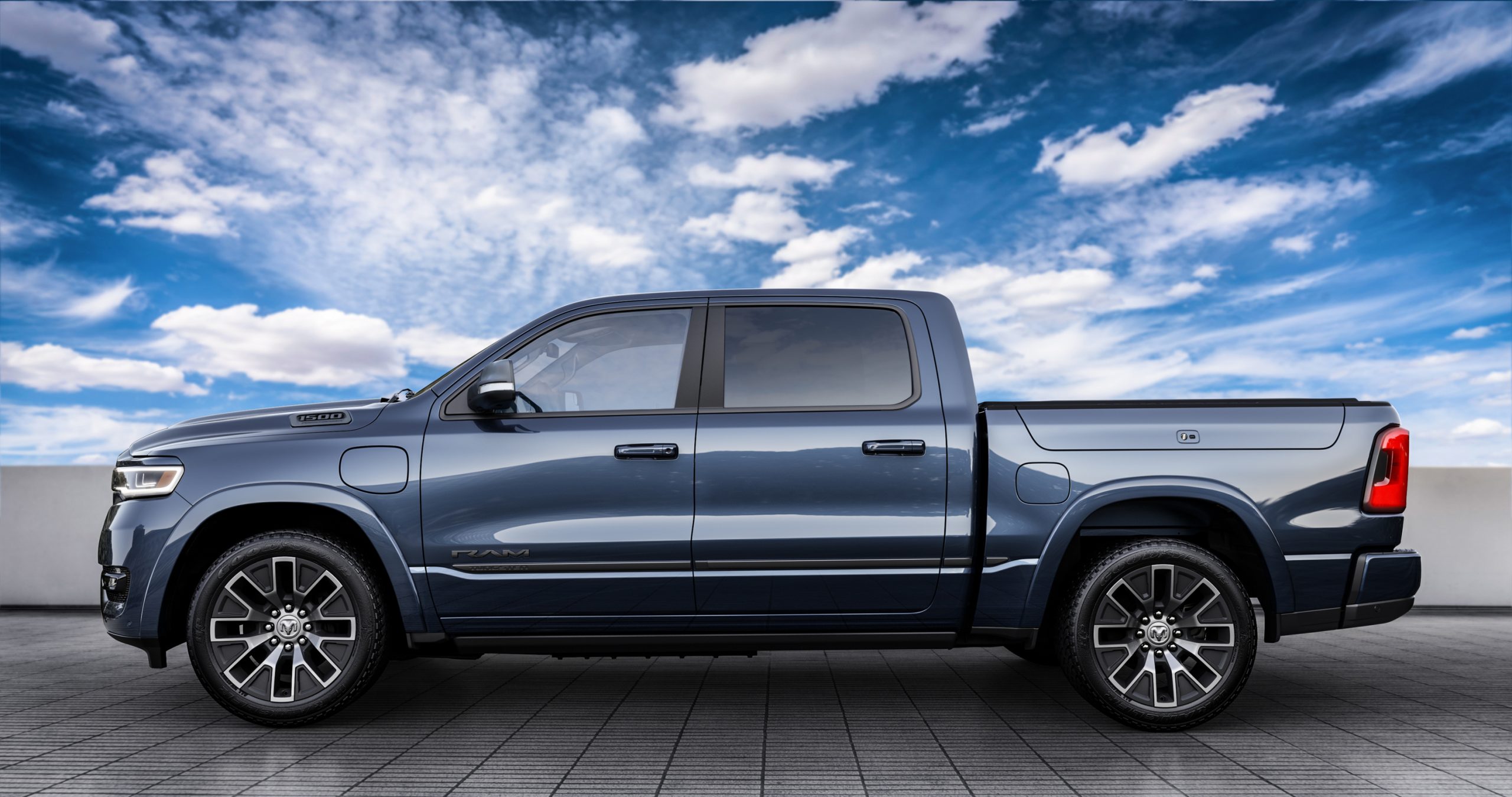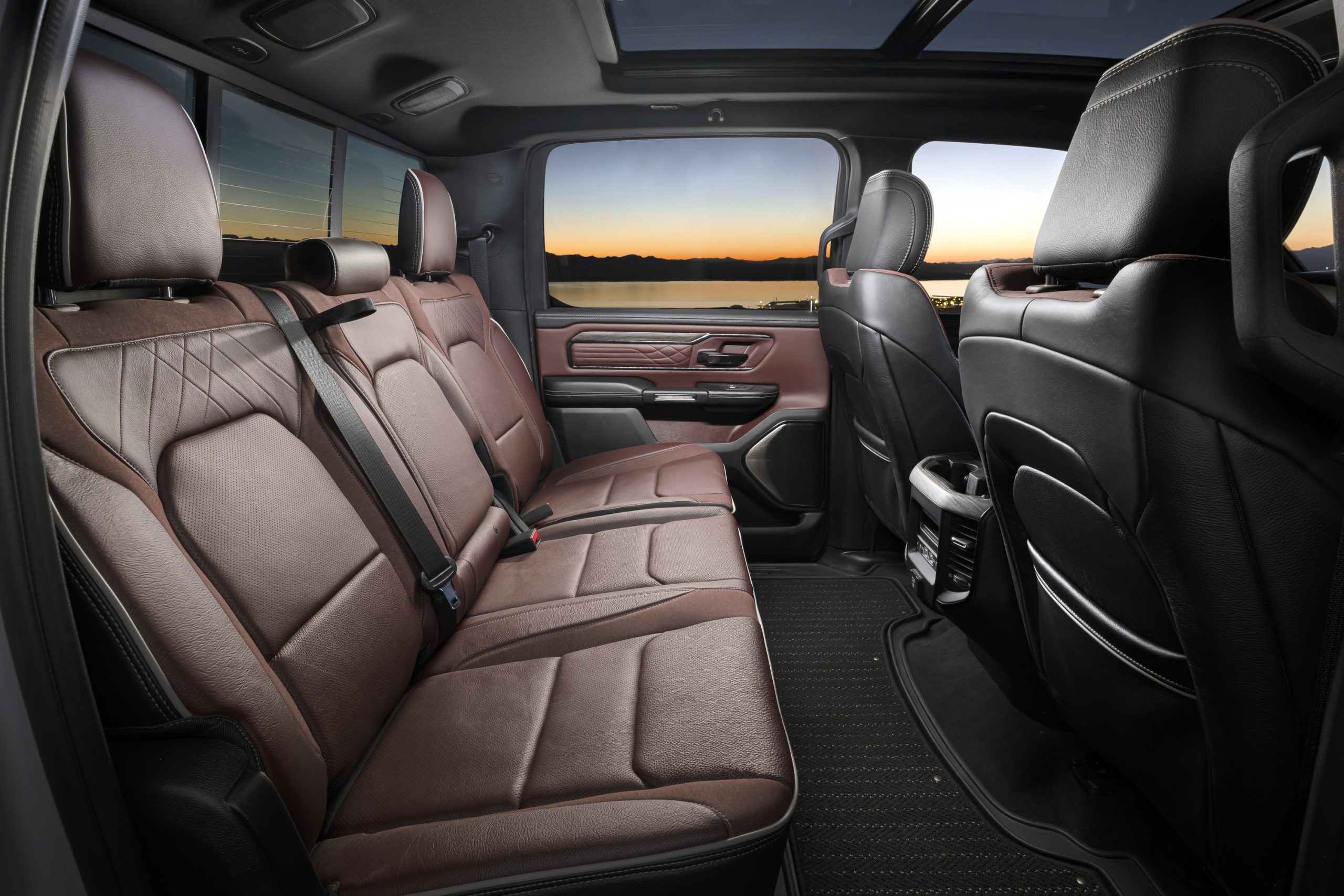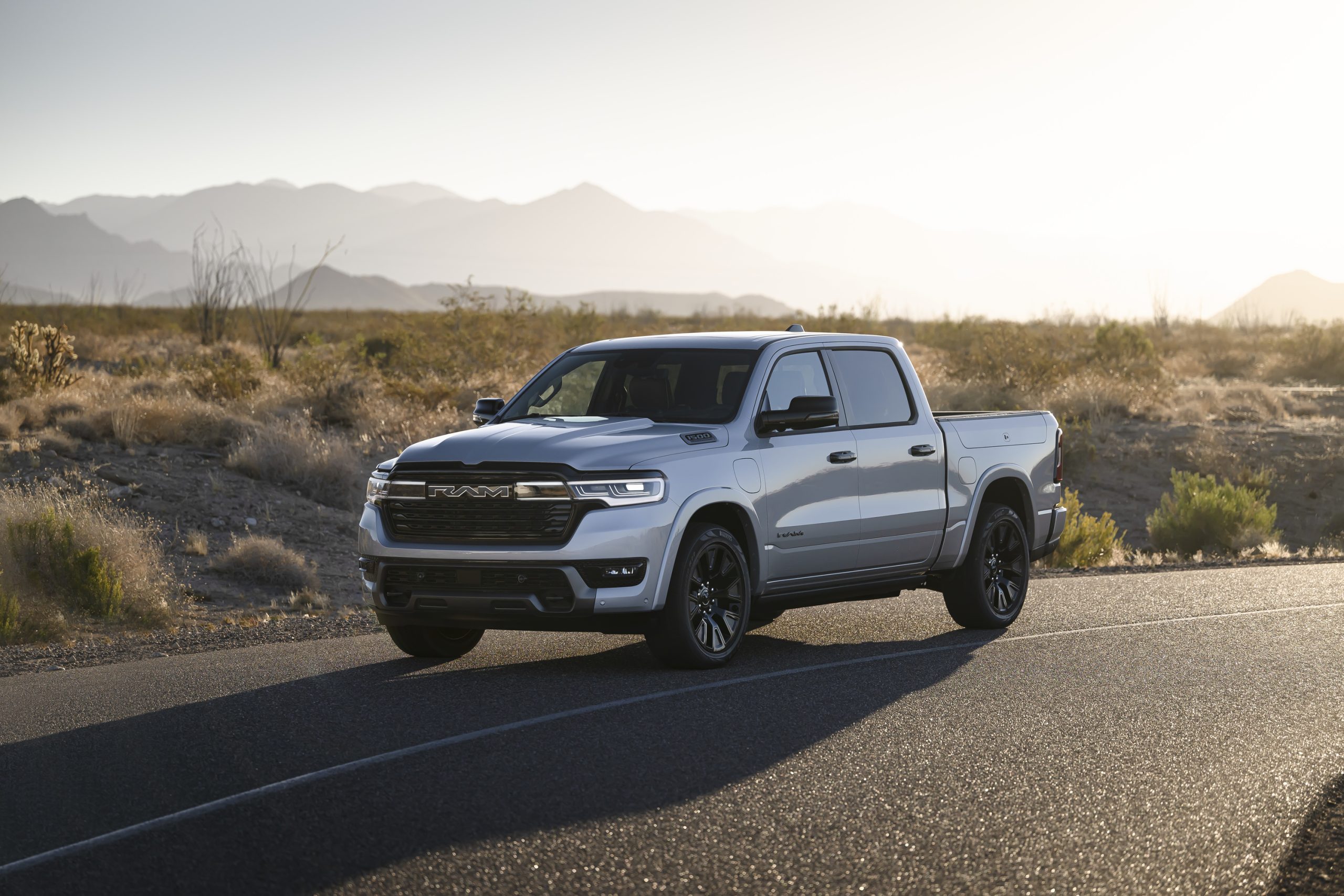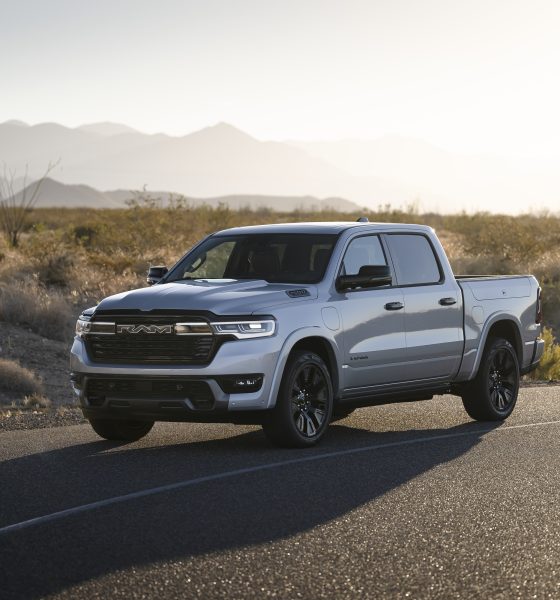Stellantis has unveiled its new 2025 Ram 1500 Ramcharger, which features both battery-electric motors and a gas engine to recharge on the go.
According to a press release shared by Stellantis on Tuesday, the Ram 1500 Ramcharger will feature 250-kW front and 238-kW rear electric drive modules, as powered by a 130-kW generator and a 92-kWh battery. Between these and a 3.6-liter, V6 gas engine, the truck is expected to offer up to 690 miles of range, with the gas-powered hardware turning on to charge the truck once the battery runs out of power.
The partially electric truck will essentially function like a plugin hybrid electric vehicle (PHEV).
The Ramcharger also boasts a 0-60 mph acceleration of 4.4 seconds, along with 663 horsepower, 615 lb.-ft. Of torque, and up to 14,000 pounds of towing with payloads up to 2,625 pounds. The company says that the truck will be able to gain 50 miles of range in just 10 minutes using 400-volt fast charging at a capacity of up to 145 kW.
“With unlimited battery-electric range, the Ram 1500 Ramcharger is the pinnacle of the light-duty pickup truck segment and the ultimate electric truck,” said Tim Kuniskis, Ram brand CEO for Stellantis. “The new Ramcharger is a beast of a light duty – 663 horsepower, 615 lb.-ft of torque, 4-second 0-60 mph, 14,000 lbs. of towing… and zero need for a public charger.”
The partially electric pickup will be built on the Stellantis STLA Frame platform, and it will feature advanced driver assistance system (ADAS) capabilities, including the Level 2 hands-free highway assist. The vehicle is also set to include regenerative driving modes, a set of e-shifter buttons, a 1,228-watt Klipsch audio system with 23 speakers and more.
It will include adjustable driving modes and air suspension with the following settings:
Driving Mode settings for the 2025 Ram 1500 Ramcharger
- Auto
- Sport
- Tow
- Snow
- Off-Road
Air Suspension settings for the 2025 Ram 1500 Ramcharger
- Entry/Exit
- Aero
- Normal
- Off-Road 1
- Off-Road 2
The electric pickup will also include a 400-volt DC fast-charging port on the front quarter panel on the driver’s side. It also has a power tailgate and interior features such as a 14.5-inch front touchscreen, a 12.3-inch instrument cluster, a 10.25-inch passenger screen, a digital rearview mirror, a Head-Up Display (HUD) and more.
Those who are interested in buying the Ram 1500 Ramcharger can reserve a spot here with just a $100 refundable membership charge.
You can see a few more images of the forthcoming Ramcharger below.

Credit: Stellantis

Credit: Stellantis

Credit: Stellantis

Credit: Stellantis
Earlier this year, Stellantis announced the fully electric Ram 1500 REV, which reportedly ran out of reservation spots a little over a week after it went live. The upgraded trim of the electric pickup is expected to have a 229 kWh battery pack offering up to 500 miles of range, while the standard range option will feature a 168 kWh battery with up to 350 miles of range.
The announcement arrives amidst increased competition in the electric pickup sector, including direct Ram 1500 REV competitors like the Ford F-150 Lightning, the Chevy Silverado EV and the Rivian R1T. Although it’s a less conventional electric truck, the Tesla Cybertruck will also begin deliveries later this month.
Lucid Motors adopts Tesla’s NACS, leaving only Volkswagen and Stellantis
What are your thoughts? Let me know at zach@teslarati.com, find me on X at @zacharyvisconti, or send your tips to us at tips@teslarati.com.

News
Elon Musk’s Grok AI to be used in U.S. War Department’s bespoke AI platform
The partnership aims to provide advanced capabilities to 3 million military and civilian personnel.

The U.S. Department of War announced Monday an agreement with Elon Musk’s xAI to embed the company’s frontier artificial intelligence systems, powered by the Grok family of models, into the department’s bespoke AI platform GenAI.mil.
The partnership aims to provide advanced capabilities to 3 million military and civilian personnel, with initial deployment targeted for early 2026 at Impact Level 5 (IL5) for secure handling of Controlled Unclassified Information.
xAI Integration
As noted by the War Department’s press release, GenAI.mil, its bespoke AI platform, will gain xAI for the Government’s suite of tools, which enable real-time global insights from the X platform for “decisive information advantage.” The rollout builds on xAI’s July launch of products for U.S. government customers, including federal, state, local, and national security use cases.
“Targeted for initial deployment in early 2026, this integration will allow all military and civilian personnel to use xAI’s capabilities at Impact Level 5 (IL5), enabling the secure handling of Controlled Unclassified Information (CUI) in daily workflows. Users will also gain access to real‑time global insights from the X platform, providing War Department personnel with a decisive information advantage,” the Department of War wrote in a press release.
Strategic advantages
The deal marks another step in the Department of War’s efforts to use cutting-edge AI in its operations. xAI, for its part, highlighted that its tools can support administrative tasks at the federal, state and local levels, as well as “critical mission use cases” at the front line of military operations.
“The War Department will continue scaling an AI ecosystem built for speed, security, and decision superiority. Newly IL5-certified capabilities will empower every aspect of the Department’s workforce, turning AI into a daily operational asset. This announcement marks another milestone in America’s AI revolution, and the War Department is driving that momentum forward,” the War Department noted.
News
Tesla FSD (Supervised) v14.2.2 starts rolling out
The update focuses on smoother real-world performance, better obstacle awareness, and precise end-of-trip routing, among other improvements.

Tesla has started rolling out Full Self-Driving (Supervised) v14.2.2, bringing further refinements to its most advanced driver-assist system. The new FSD update focuses on smoother real-world performance, better obstacle awareness, and precise end-of-trip routing, among other improvements.
Key FSD v14.2.2 improvements
As noted by Not a Tesla App, FSD v14.2.2 upgrades the vision encoder neural network with higher resolution features, enhancing detection of emergency vehicles, road obstacles, and human gestures. New Arrival Options let users select preferred drop-off styles, such as Parking Lot, Street, Driveway, Parking Garage, or Curbside, with the navigation pin automatically adjusting to the user’s ideal spot for precision.
Other additions include pulling over for emergency vehicles, real-time vision-based detours for blocked roads, improved gate and debris handling, and extreme Speed Profiles for customized driving styles. Reliability gains cover fault recovery, residue alerts on the windshield, and automatic narrow-field camera washing for new 2026 Model Y units.
FSD v14.2.2 also boosts unprotected turns, lane changes, cut-ins, and school bus scenarios, among other things. Tesla also noted that users’ FSD statistics will be saved under Controls > Autopilot, which should help drivers easily view how much they are using FSD in their daily drives.
Key FSD v14.2.2 release notes
Full Self-Driving (Supervised) v14.2.2 includes:
- Upgraded the neural network vision encoder, leveraging higher resolution features to further improve scenarios like handling emergency vehicles, obstacles on the road, and human gestures.
- Added Arrival Options for you to select where FSD should park: in a Parking Lot, on the Street, in a Driveway, in a Parking Garage, or at the Curbside.
- Added handling to pull over or yield for emergency vehicles (e.g. police cars, fire trucks, ambulances).
- Added navigation and routing into the vision-based neural network for real-time handling of blocked roads and detours.
- Added additional Speed Profile to further customize driving style preference.
- Improved handling for static and dynamic gates.
- Improved offsetting for road debris (e.g. tires, tree branches, boxes).
- Improve handling of several scenarios, including unprotected turns, lane changes, vehicle cut-ins, and school buses.
- Improved FSD’s ability to manage system faults and recover smoothly from degraded operation for enhanced reliability.
- Added alerting for residue build-up on interior windshield that may impact front camera visibility. If affected, visit Service for cleaning!
- Added automatic narrow field washing to provide rapid and efficient front camera self-cleaning, and optimize aerodynamics wash at higher vehicle speed.
- Camera visibility can lead to increased attention monitoring sensitivity.
Upcoming Improvements:
- Overall smoothness and sentience.
- Parking spot selection and parking quality.
News
Tesla is not sparing any expense in ensuring the Cybercab is safe
Images shared by the longtime watcher showed 16 Cybercab prototypes parked near Giga Texas’ dedicated crash test facility.

The Tesla Cybercab could very well be the safest taxi on the road when it is released and deployed for public use. This was, at least, hinted at by the intensive safety tests that Tesla seems to be putting the autonomous two-seater through at its Giga Texas crash test facility.
Intensive crash tests
As per recent images from longtime Giga Texas watcher and drone operator Joe Tegtmeyer, Tesla seems to be very busy crash testing Cybercab units. Images shared by the longtime watcher showed 16 Cybercab prototypes parked near Giga Texas’ dedicated crash test facility just before the holidays.
Tegtmeyer’s aerial photos showed the prototypes clustered outside the factory’s testing building. Some uncovered Cybercabs showed notable damage and one even had its airbags engaged. With Cybercab production expected to start in about 130 days, it appears that Tesla is very busy ensuring that its autonomous two-seater ends up becoming the safest taxi on public roads.
Prioritizing safety
With no human driver controls, the Cybercab demands exceptional active and passive safety systems to protect occupants in any scenario. Considering Tesla’s reputation, it is then understandable that the company seems to be sparing no expense in ensuring that the Cybercab is as safe as possible.
Tesla’s focus on safety was recently highlighted when the Cybertruck achieved a Top Safety Pick+ rating from the Insurance Institute for Highway Safety (IIHS). This was a notable victory for the Cybertruck as critics have long claimed that the vehicle will be one of, if not the, most unsafe truck on the road due to its appearance. The vehicle’s Top Safety Pick+ rating, if any, simply proved that Tesla never neglects to make its cars as safe as possible, and that definitely includes the Cybercab.










